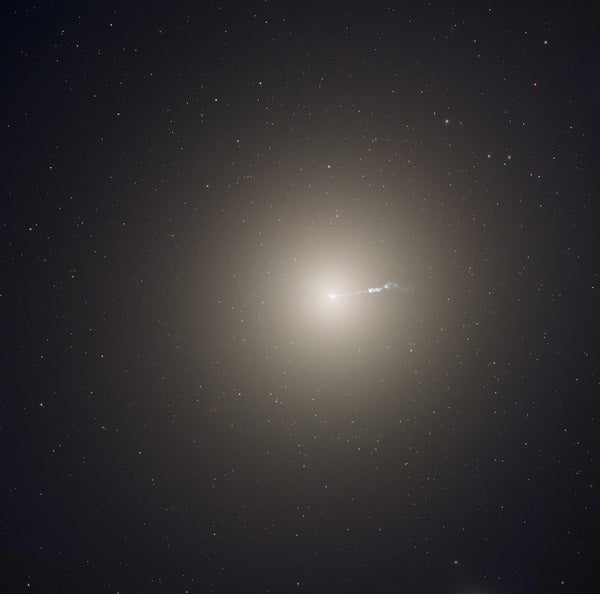About a century ago, astronomers first noticed what appeared to be a ray of light shooting away from the center of M87, an elliptical galaxy some 54 million light-years distant. We now know this jet, which stretches thousands of light-years beyond the galaxy, was generated by the supermassive black hole at the center, referred to as M87*.
The material in the jet is plasma, which is composed of atoms that have been heated so much that their electrons are torn away, creating a mixture of positively charged atoms (or ions) and those stripped-away electrons. In particular, electrons spiraling along the twisted magnetic fields within the jet create the bluish glow we observe in visible light. (This process is called synchrotron radiation.) The jets also contain photons and neutrinos. Particles in the jets can be accelerated to nearly the speed of light and are not necessarily emitted in a steady stream. In M87 and other galaxies, astronomers have noted bright knots or clumps of material in the jets, which move outward over time.
If you’re wondering where this plasma came from in the first place — after all, as we frequently say, nothing can escape a black hole — you need to look at the region directly around the black hole. As gas and dust are pulled toward the black hole by gravity, it forms a large, swirling structure called an accretion disk. Infalling material moves from the outer disk toward the event horizon, the point of no return, and disappears into the black hole. But not all the material from the accretion disk makes it into the black hole. Some is expelled before it can reach the event horizon; this is what fuels the jet.
Astronomers aren’t exactly sure how material is funneled into the jet, though the prevailing theory says it may be due to powerful magnetic fields around the black hole. Alternatively, perhaps the rotational energy of the black hole itself powers the jets, or at least contributes to the process. What we do know is these jets act as the most powerful particle accelerators in the known universe, and electrons and atomic nuclei can be shot outward with extremely high energies, becoming the cosmic rays that streak through space.










